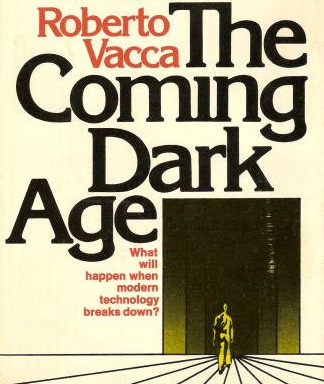
The book is 221 pages of nothing short of a window of what will be…in the days and years after the SHTF. Vacca is (he’s still living) a mathematician and computer guru who explains all about what will happen when systems of infrastructure break down around us. Rather than just some small-scale, local disaster, Vacca refers to the complete collapse of all national systems globally. He delves into all of the systems: electrical, water, waste-treatment, and population dynamics to include urban sprawl with these collapses.
The author chronicles the death of a city, making New York City his test-case. He shows what will happen, and why. From a global perspective, he points out a return to feudalism/monasticism after a worldwide social and economic collapse precedes it. He predicts the rise of local barons and authoritarian movements after a vast population decline. Once again, this is not a novel: these are forecasts using raw data and computer models, coupled with specific events.
One of those events, for example is the great blackout of November 9, 1965 in the northeastern U.S. and in Ontario with periods of no electricity for up to 14 hours for approximately 30 million people due to an instability in the transmission network. No vehicles could refuel, and a loss of 40,000 megawatts of power occurred. More than 600,000 people were trapped in the subways. Vacca mentions such things as grid failure and also a brief notation of the Carrington event.
He does not specifically detail what event will cause such systems to fail. EMP data was sketchy back then; however, the knowledge did exist, and Vacca concentrated on the loss of the systems themselves…all systems of infrastructure…that make up our modern society. He then tells what will occur afterwards. The “arrival of the dark ages,” Vacca explained, are based on two features: a sharp reduction in population followed by a gradual decline, and also the breakup of systems into smaller, independent, self-sufficient systems.
Vacca believed that city-states would form in the rural communities, with each focusing upon one or two specialties of production per state and a complete return to barter as a means of exchange of goods and services. He had a vision of how knowledge and technology, both technical and the employment of it should be chronicled and saved for a time after the world’s collapse. He wrote the following:
“Monastic communities or similar systems should be set up to preserve the essential elements of our present civilization during the Dark Age; and to preserve our knowledge for the civilization to come.”
Fairly profound, wouldn’t you agree? Vacca defined Dark Age on pg. 174 as “the period elapsing between the time in which maximum overshoot [collapse] is reached and the time when the low point is passed and a new period of expansion will begin [Renaissance/rebirth].”
He went on to describe how the Dark Age would begin sooner and last longer in the U.S. than in the rest of the world due to our use of and complete dependence on systems that are rooted in technology and electricity. He saw huge migrations of people with the collapse of nations, as well as the return to a type of futuristic feudalism where self-sufficiency rather than interdependency is championed. Chapter 16 is only ten pages; however, it lays out what is to come after the SHTF.
Feudal structures (architectural as well as social), the best locations for fortified communities, skills and tools needed in the time after the collapse…it’s all there, right for the reader’s taking. He explains how socially such communities would be governed, and talks about the marauders who will range far and wide looking for power through conquest of these city-state communities.
The book is a quick read, and in this author’s opinion a great one. The reason I stress that latter part is it important to have a type of blueprint with which not only to rebuild, but to understand the reasons and motives that prompt others to rebuild “differently” from you or your intentional community/group’s ideals and manners. Roberto Vacca had a vision of a time that is not too far in the future from where we are, and maybe even sooner than we think. I strongly recommend it for your studies and for your library of preparedness for things coming down the line. Keep up the good fight! JJ out.
